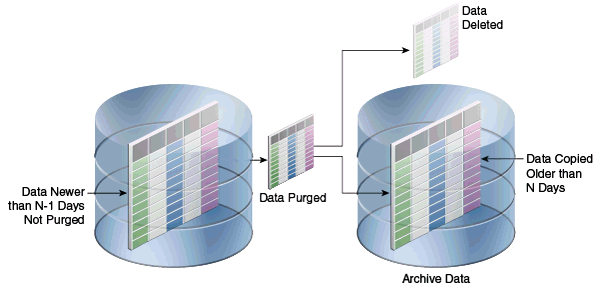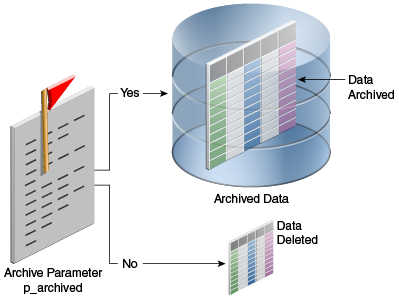D Setting Up Archive and Purge Procedures
This chapter describes how to archive and purge data from the OAAM database using SQL scripts.
This chapter includes the following sections:
D.1 Overview
The archive and purge process allows the releasing of data that is not required anymore for rules evaluation or fraud investigation.
-
Archiving is the process of moving data from main transactional tables to the archive tables.
-
Purging is the process of deleting obsolete data that is not required by the system from tables because of data growth issues.
Not all the tables are purged since many of them do not have data growth issues.
"Purging data" is different from "backing up data". A data backup is for the recovery of data if loss occurs; purges are for keeping the runtime tables free of old data. Regardless, to protect your data, database backups should be performed on a regular basis with the help of a database administrator.
The following data can be archived or purged using the scripts provided in the archive IDM_ORACLE_HOME/oaam/oaam_db_scripts/oaam_db_purging_scripts.zip:
-
Login and devices data
-
Rule Logs data
-
Auto Learning data
-
Transactions and Entities data
-
Profile data
Archive and purge criteria is based on the create/update timestamp of the records. This is specified using the retention period described using number of days.
The following is the overview of the archive and purge process:
-
Determine the retention period (usually 180 days; that is 6 months)
-
If the transactions feature is used and you want to specify different retention period based on the transaction type or entity, refer to Section 20.6, "Setting Targeted Purging for Transaction Data Per Transaction Definition," and Section 19.4, "Setting Up Targeted Purging for Entity Data."
-
Determine whether to purge or archive.
-
Deploy the purge related stored procedures into the OAAM database. This is a one-time job.
-
Determine what types of data have to be archived and purged.
-
Schedule the related scripts to run on regular intervals or manually run the scripts when required.
-
Check for entries where the
LOG_TYPEis99in the database tableV_SYS_LOGS.
Note:
Rules may behave differently if the data that they look for is purged. For example, a rule is looking for 6 month data and you are purging data that is 9 days or older.The next sections describe the above in detail.
D.2 Setting Up the Scripts in Database
To archive and purge OAAM data, you must set up the one-time scripts.
D.2.1 Non-EBR Schema
Follow these steps to set up the scripts if you have installed OAAM database in a non-EBR (edition-based redefinition) schema:
-
Create a scripts directory
oaam_purge_script. -
Unzip the scripts archive
IDM_ORACLE_HOME/oaam/oaam_db_scripts/oaam_db_purging_scripts.zipto the scripts directory. -
Log in to the database using the
sysorsysdbaaccount. -
Grant the following privileges to the OAAM schema so that stored procedures can be created and executed:
GRANT create any procedure TO <schema_name>;GRANT create any table TO <schema_name>;GRANT create any index TO <schema name>;GRANT create procedure TO <schema_name>;GRANT execute any procedure TO <schema_name>; -
Now connect to the OAAM schema using the OAAM user name and password. For example:
sqlplus <oaam_db_user_name>/<oaam_db_password> -
Run the
create_purge_proc.sqlscriptSQL> @oracle_db/create_purge_proc.sql -
Validate the stored procedures to make sure they are valid and without errors.
D.2.2 EBR Schema
Edition-based redefinition (EBR) enables you to upgrade the database component of OAAM while it is in use, thereby minimizing or eliminating down time.
To set up the archive and purge process that supports EBR, proceed as follows:
-
Log in to database using the
sysorsysdbaaccount. -
Grant the following privileges to the OAAM schema:
GRANT create any procedure TO <SCHEMA_NAME>GRANT create any table TO <SCHEMA_NAME>GRANT create any index TO <SCHEMA_NAME>GRANT create procedure TO <SCHEMA_NAME>GRANT create view TO <SCHEMA_NAME>GRANT execute any procedure TO <SCHEMA_NAME>ALTER user <SCHEMA_NAME> enable editionsGRANT use on EDITION ORA$BASE to <SCHEMA_NAME>Exit -
Log in to the OAAM Schema using the OAAM database user name and password.
For example,
sqlplus <oaam_db_user_name>/<oaam_db_password> -
Log in as the
<schema_name>user and run thecreate_purge_proc.sqlscript.@ oracle_db/oracle_ebr/create_purge_proc.sql <EDITION_VERSION>For example,
@ /oracle_db/oracle_ebr/create_purge_proc.sql ORA$BASE -
Validate the stored procedures to make sure they are valid and without errors.
D.3 Running the Archive and Purge Scripts
To run the archive and purge scripts, proceed as follows:
-
Set the
p_days1andp_archivedparameters using a text editor when you run the scripts. All the scripts have these two parameters that you can set. Table D-1 describes these parameters.Table D-1 Archive and Purge Routine Parameters
Variable Name Default Value Description p_days1
180
Retention period in days. Data older than this many number of days will be archived or purged.
p_archived
Y
Y or N for Yes and No respectively. If "Y" then data will be archived (in archive tables), otherwise data will be purged based on the retention period.
-
Select the scripts to run based on the data that has to be archived or purged. Table D-2 lists the types of data and corresponding script name.
Table D-2 Archive and Purge Scripts Based on Types of Data
Type of Data Corresponding Script Login, Device Data
exec_sp_purge_tracker_data.sql
Rules, Policy Log Data
exec_sp_purge_rule_log.sql
Transactions, Entities Data
exec_sp_purge_txn_log.sql
Autolearning Data
exec_sp_purge_workflow_data.sql
Profile Data
exec_sp_purge_profile_data.sql
Cases related Data
exec_sp_purge_case_data.sql
Monitor Data
exec_v_monitor_purge_proc.sql
-
Log in to the OAAM database using OAAM database user name and password and execute the selected scripts.
-
Check the corresponding log file and see if there are any errors or warnings.
-
If archiving is selected, then make sure to take a backup of the archive tables so that data can be restored if needed.
Archive and purge criteria is presented in the following table.
Table D-3 Archive and Purge Criteria
D.4 Running Partition Maintenance Scripts
In case the partitioned version of OAAM database is used, there are related scripts to drop the partitions.
D.4.1 Dropping Weekly Partitions
To drop weekly partitions, proceed as follows:
-
Run this script at the end of every two weeks starting from your database creation date.
-
To change the default retention period, open the script
Drop_Weekly_Partition_tables.sqland set the retention period in days. Default is set to15days (two weeks). -
Log in to the OAAM database using the OAAM database user name and password.
-
Execute the script
Drop_Weekly_Partition_tables.sql.
D.4.2 Dropping Monthly Partitions
To drop monthly partitions, proceed as follows:
-
Run this script at the end of each month to drop partitions that are older than the sixth month.
-
To change the default retention period, open the script
Drop_Monthly_Partition_tables.sqland set the retention period in days. Default is set to180days (6 months). -
Log in to the OAAM database using the OAAM database user name and password.
-
Execute the script
Drop_Monthly_Partition_tables.sql.
D.5 Minimum Data Retention Policy for OLTP (Online Transaction Processing) Tables
Based on the Oracle Adaptive Access Manager system requirement, the minimum data retention policy for various OLTP (online transaction processing) tables are shown below, but users should determine the data retention period based on their business requirements.
Table D-4 Minimum Data Retention Policies
| Data | Retention Policy |
|---|---|
|
Device Fingerprinting Data |
Minimum of 6 months or 180 days |
|
In-Session Transactional Tables |
Minimum of 6 months or 180 days |
|
Transaction and Entity Data |
Data that has not been updated in the last 180 days is purged by default. |
|
Auto-learning and Workflow Tables |
Retention for hours, days, months, and years is listed below.
|
|
Rule Log Data |
The archive and purge script will archive and purge all rule log data that is 30 days older (This value should be set based on the customer care requirement. If the reporting database is used, then, rule logging data retention should be less than 30 days. |
D.6 Best Practices/Guidelines for Running Purge Scripts
Best/practices guidelines for running purge scripts are as follows:
-
Determine the retention period based on the business requirements and rules and policies used
-
Perform regular purge/archive
-
Make sure replication is not enabled during the window when these scripts are run
-
Run these during off peak load hours which Oracle recommends you do. Archive and purge could be resource (like CPU) intensive.
-
If archiving is required, make sure there is enough disk space available on the database server since the data would be moved to archive tables instead of simply purging. Archival space should be equal to or greater than the current table's storage.
-
Plan your purging strategy since purging requires a significant amount of time if there are millions of rows that need to be deleted or copied from the database.
-
In a multi-data center, it is recommended that you run purges at low data flow since the data in tables is replicated. You should consult your database administrator if you have multidimensional clustering (MDC) set up and require purging.
-
Oracle recommends that custom purging scripts only include the tables utilized by the out of the box purging scripts provided. The alterations to the provided purge scripts can include parameterization for user ID. Such alterations should be thoroughly tested before being used in production to ensure they function as expected.
D.7 Details of Data that is Archived and Purged
Details of data that is purged and the corresponding archived tables are presented in the following sections.
D.7.1 Login and Device Data
| Login and Device Tables | Corresponding Archived Tables |
|---|---|
|
VCRYPT_TRACKER_NODE |
VCRYPT_TRACKER_NODE_PURGE |
|
VCRYPT_TRACKER_NODE_HISTORY |
VCRYPT_TRACKER_NODE_HISTORY_PURGE |
|
VCRYPT_TRACKER_USERNODE_LOGS |
VCRYPT_TRACKER_USERNODE_LOGS_PURGE |
|
VT_DYN_ACT_EXEC_LOG |
VT_DYN_ACT_EXEC_LOG_PURGE |
|
VT_SESSION_ACTION_MAP |
VT_SESSION_ACTION_MAP_PURGE |
|
VT_USER_DEVICE_MAP |
VT_USER_DEVICE_MAP_PURGE |
|
VCRYPT_ALERT |
VCRYPT_ALERT_PURGE |
|
VCRYPT_USERS_HIST |
VCRYPT_USERS_HIST_PURGE |
|
V_USER_QA_HIST |
V_USER_QA_HIST_PURGE |
D.7.3 Transactions and Entities Data
Table D-7 Transactions and Entity Data Tables
| Transaction Tables | Corresponding Archived Tables |
|---|---|
|
VT_ENTITY_ONE |
VT_ENTITY_ONE_PURGE |
|
VT_ENTITY_ONE_PROFILE |
VT_ENTITY_ONE_PROFILE_PURGE |
|
VT_USER_ENTITY1_MAP |
VT_USER_ENTITY1_MAP_PURGE |
|
VT_ENT_TRX_MAP |
VT_ENT_TRX_MAP_PURGE |
|
VT_TRX_DATA |
VT_TRX_DATA_PURGE |
|
VT_TRX_LOGS |
VT_TRX_LOGS_PURGE |
D.7.5 Profile Data
| Transactional Tables | Corresponding Archived Tables |
|---|---|
|
VT_USER_PROFILE |
VT_USER_PROFILE_PURGE |
|
VT_DEVICE_PROFILE |
VT_DEVICE_PROFILE_PURGE |
|
VT_BASE_IP_PROFILE |
VT_BASE_IP_PROFILE_PURGE |
|
VT_IP_PROFILE |
VT_IP_PROFILE_PURGE |
|
VT_STATE_PROFILE |
VT_STATE_PROFILE_PURGE |
|
VT_CITY_PROFILE |
VT_CITY_PROFILE_PURGE |
|
VT_COUNTRY_PROFILE |
VT_COUNTRY_PROFILE_PURGE |
D.8 List of Related Stored Procedures
The create_purge_proc.sql script creates the tables and the following stored procedures to archive and purge data from the transaction tables:
-
SP_RULE_ PROC
-
SP_MODEL_ PROC
-
SP_POLICYSET_ PROC
-
SP_POLICY_ PROC
-
SP_NODE_HISTORY_ PROC
-
SP_NODE_PROC
-
SP_USER_NODE_PROC
-
SP_USER_DVC_PROC
-
SP_SESS_ACT_MAP_PROC
-
SP_WF_YEARS_PROC
-
SP_WF_MONTHS_PROC
-
SP_WF_DAYS_PROC
-
SP_WF_HOURS_PROC
-
SP_V_FPRINTS_PROC
-
SP_V_FP_MAP_PROC
-
SP_VT_DY_ACT_EX_LOG_PRO
-
SP_VT_TRX_LOGS_PROC
-
SP_VT_TRX_DATA_PROC
-
SP_VT_ENT_TRX_MAP_PROC
-
SP_VT_ENT_ONE_PRF_PROC
-
SP_VT_ENT_ONE_PROC
-
SP_VT_ENT_ONE_MAP_PROC
-
SP_VT_USER_PRF_PROC
-
SP_VT_DEVICE_PRF_PROC
-
SP_VT_IP_PRF_PROC
-
SP_VT_BASE_IP_PRF_PROC
-
SP_VT_CITY_PRF_PROC
-
SP_VT_COUNTRY_PRF_PROC
-
SP_VT_STATE_PRF_PROC
-
SP_ARCHIVE_PURGE_VCRYPT_ALERT
-
SP_ARCHPURGE_VCRYPTUSERSHIST
-
SP_ARCH_PURGE_V_USER_QA_HIST
The create_case_purge_proc.sql script creates the following stored procedures to archive and purge data from the transaction tables:
-
SP_V_CASE_PROC
-
SP_V_CASE_HIST_PROC
-
SP_V_CASE_MAP_PROC
-
SP_V_CASE_MAP_HIST_PROC
-
SP_V_ACTION_LOG_SESS_MAP_PROC
-
SP_V_ACTION_LOG_SESS_PROC
The create_v_monitor_purge_proc.sql script creates SP_V_MON_DATA_PURGE_PROC to archive and purge data from the transaction table.


